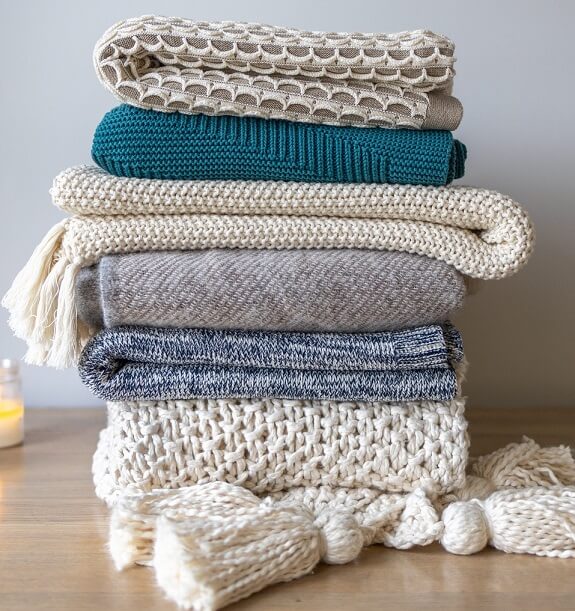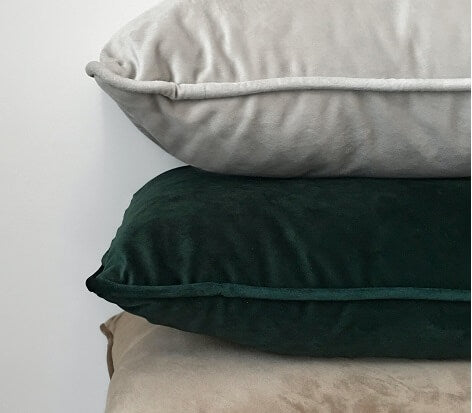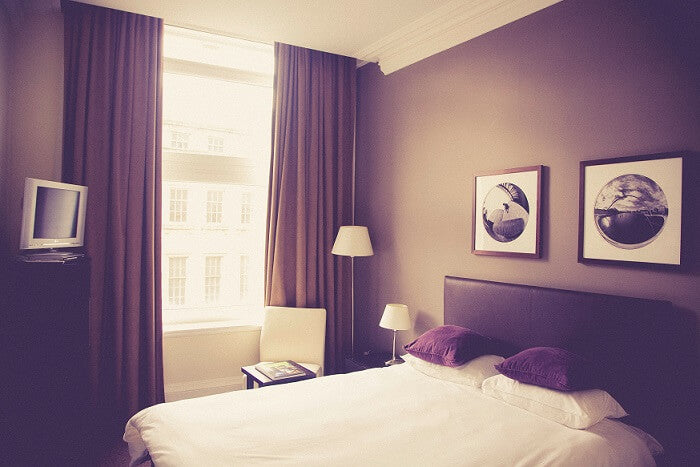When it comes to getting a good night's sleep, most people focus on factors like a comfortable mattress, cozy blankets, and a relaxing bedtime routine. However, one often-overlooked element that can significantly impact the quality of your sleep is the humble curtain. Curtains play a crucial role in temperature regulation for better sleep. By blocking out sunlight and insulating the room, curtains help maintain a comfortable and cool environment, promoting more restful sleep. If you're wondering what color curtains go with brown furniture, choose shades that enhance the warmth and tranquility of the space, like soft neutrals or rich earth tones, to create an ideal sleep setting.

Uncovering the Science: How Curtains Affect Room Temperature
Delving into the mechanics of how curtains influence the thermal dynamics of a room offers intriguing insights into their role in our sleep environment. Curtains function as a thermal barrier, playing a pivotal role in the energy exchange between the room's interior and the external environment. During the warmer months, the sun’s rays can significantly increase indoor temperatures, turning a potentially comfortable space into a stifling one. Curtains, especially those made from materials with insulating properties, mitigate this effect by blocking and reflecting solar radiation, thus preventing excessive heat accumulation within the room.
On the flip side, in cooler climates, curtains contribute to retaining warmth. They reduce heat loss by creating a layer of insulation over windows, which are often one of the weakest links in a room’s thermal envelope. The fabric of the curtains acts as a buffer zone, trapping air and reducing the rate at which heat escapes. This dual functionality not only maintains a more consistent room temperature but also contributes to energy efficiency by reducing the need for heating or cooling.
The effectiveness of curtains in regulating temperature is also influenced by their color, material thickness, and the tightness of their weave. Darker colors and denser materials excel in absorbing solar energy during the day and releasing it at night, which can be particularly beneficial during the colder months. Understanding these scientific principles underpinning how curtains affect room temperature allows us to make informed choices, ensuring our sleeping environments are both comfortable and conducive to restorative rest.
The Sun's Role: Curtains as Light and Heat Blockers
Curtains serve a dual purpose in our battle against the relentless encroachment of sunlight into our sleep sanctuaries. The sun, a vibrant source of life, can become a disruptor of rest, intruding with both its brilliance and its warmth. This is where curtains step into the limelight, not just as decorative elements but as critical tools in managing light and temperature. Blackout curtains, in particular, offer an effective solution, casting a shadow over the sun’s attempts to disturb our slumber. They are engineered to shield our bedrooms from unwanted light, ensuring darkness that is conducive to sleep. This darkness is essential for the production of melatonin, the hormone responsible for regulating sleep cycles, thus facilitating a smoother transition to sleep.
But the role of curtains extends beyond merely casting shadows. They are the first line of defense against the heat that accompanies daylight. By blocking the sun's rays, curtains reduce the thermal gain inside a room, helping to keep it cooler during hot days. This is particularly beneficial in summer months when temperatures can soar, making it challenging to maintain a comfortable sleeping environment. The material and color of the curtains play a significant role in their effectiveness as heat blockers. Fabrics that are dense and in darker shades are better at absorbing heat, preventing it from permeating the room, while lighter-colored curtains reflect sunlight, contributing to a cooler room atmosphere. Through these mechanisms, curtains assert themselves as indispensable allies in creating the optimal conditions for restful sleep.
Enhancing Sleep Quality Through Temperature Control
Achieving the perfect sleeping conditions goes beyond just the softness of our pillows and the firmness of our mattresses; it profoundly encompasses the ambiance of our bedrooms, notably the temperature. Studies underscore the importance of a cooler bedroom environment in facilitating deep, uninterrupted sleep. The optimal temperature, set within the 60-67 degrees Fahrenheit range, is not arbitrary. This cooler climate aids in reducing our internal body temperature, a natural precursor to the sleep cycle, thus signaling to our bodies that it's time for rest. Leveraging curtains as a method of thermal regulation emerges as an ingenious approach to maintaining this ideal temperature. Their ability to insulate the room against heat during summer days or retain warmth during the chill of winter nights positions them as an essential component in the sleep health toolkit. The strategic use of curtains not only sustains a conducive sleep temperature but also indirectly supports the body's physiological preparation for sleep by fostering an environment that nudges the internal clock towards restfulness. Engaging with the right type of curtains can thus transform your bedroom into a sanctuary optimized for sleep, simply by moderating the external factors that influence room temperature. This role of curtains in temperature control is a testament to their utility in not just enhancing the aesthetic appeal of a bedroom but in elevating the quality of sleep through a cooler, more comfortable sleep environment.
Choosing the Right Curtains for Thermal Regulation
In the quest for curtains that effectively contribute to temperature regulation within your bedroom, prioritizing fabric choice and color becomes essential. Opt for materials renowned for their insulating capabilities, such as heavyweight cotton, wool, or even thermal curtains specifically designed for this purpose. These fabrics play a significant role in hindering heat transfer, either by keeping warm air out during summer or retaining it during winter months, thus acting as a thermal shield for your room.
While the texture and weave of the curtain material are vital, color selection should not be overlooked. Lighter hues are beneficial for reflecting sunlight, aiding in keeping the room cooler when temperatures rise. Conversely, curtains in darker shades are adept at absorbing solar energy, which can help warm a room when it's cooler outside. This balance between color and material functionality is key to achieving the desired thermal regulation effect.
Additionally, consider the size and fit of the curtains. Ensuring they are appropriately sized for your windows can maximize their efficiency in temperature control. Curtains that extend beyond the window frame and reach the floor can offer better insulation, as they cover more surface area and minimize air leaks.
Finally, while aesthetics may not directly impact thermal regulation, selecting curtains that harmonize with your room's decor will enhance your overall satisfaction and comfort, contributing to a serene sleep environment. By marrying the practical aspects of fabric type, color, and size with the stylistic elements of your bedroom, you can choose curtains that are both functional in temperature regulation and pleasing to the eye.

Beyond Temperature: Additional Benefits of Using Curtains
Curtains not only play a vital role in regulating the temperature to foster better sleep conditions but also extend their utility to other aspects of a restful night. A significant advantage of incorporating curtains into your bedroom is their ability to dampen external noise. The thick fabric of blackout or heavy-duty curtains can act as a sound barrier, mitigating the intrusion of traffic noise or the early morning clamor of birds, thereby ensuring a quieter sleeping environment. This noise reduction feature is particularly beneficial for light sleepers or those living in bustling urban areas, where the cacophony of the city can disrupt sleep patterns.
Furthermore, curtains contribute to enhanced privacy within the sleep space. The opaque nature of blackout curtains or thickly woven fabrics shields your personal space from the outside world, ensuring that your moments of rest are not on display. This sense of seclusion is not just about visual privacy but also about creating a personal retreat where relaxation and disconnection from the external world can be fully embraced.
The utility of curtains is also evident in their role in protecting against UV rays and reducing the potential for furniture and floorings to fade over time. By filtering or completely blocking sunlight, curtains help preserve the interior decor, extending the lifespan of your investments. Through these multifaceted benefits, curtains emerge as an indispensable element in the quest for a tranquil and restorative sleeping environment.
Implementing Curtains into Your Sleep Hygiene Routine
To leverage the benefits of curtains for enhanced sleep quality, start by drawing them shut during peak sunlight hours to keep your space cool and dim. Opting for blackout varieties can significantly darken the room, mimicking the natural onset of nighttime and facilitating a conducive environment for sleep. Selecting fabrics that offer superior insulation will aid in stabilizing your room's temperature, creating a consistent and comfortable setting for sleep throughout the year. Regular care and maintenance of your curtains are also crucial; a simple routine of cleaning and inspecting them for wear and tear can ensure they remain effective in their role. Integrating these practices into your daily routine can transform your sleep space into a haven of tranquility, setting the stage for a night of deep, restorative sleep.






